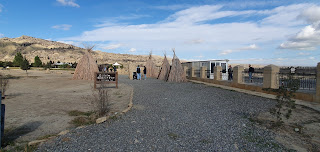Он состоит из приятного, но весьма маленького музея, куда стекаются группы туристов со всего света (индусы) и местные школьные группы. Он это типа пирамида с кучей найденных в этих местах археологических находок: украшения, посуда, кусочки росписей, скелетом. Также элементом интерактивности, то есть мониторы, что рассказывают о жизни древних людей от начала поселения до конца. Всё это выглядит максимально интересно, хотя формат некоторой темноты в зал не слишком удобен для чтения надписей. Можно потом зайти в сувенирную лавку и туалет есть чистый.
Далее мы отправляемся на сами раскопки, где большая часть пути лежит по не слишком удобным камням (смотрите под ноги). Сами рисунки довольно сложно рассмотреть, хотя мощности камерыхватило, ну и фотоаппарат помог запечатлеть эти объекты. Собственно все они различаются стилем исполнения, а значит и временем создания. Масштабность места в 537 гектаров не позволяет увидеть всё. Так открыта нам лишь малая часть и подписи к рисункам есть на двух языках азербайджанском и английском. Честно гида надо иметь с собой для хорошего понимания истории места. Начало работ самих было ещё в 1966 году, хотя исследования велись и раньше.
Честно мне понравилось, как все это сделали (оформили). Естественно сохранение любой истории есть наша память и качество жизни хорошее.
It consists of a pleasant but rather small museum, which attracts groups of tourists from all over the world (Indians) and local school groups. It is a type of pyramid with a bunch of archaeological finds found in these places: jewelry, dishes, pieces of paintings, a skeleton. Also an element of interactivity, that is, monitors that tell about the life of ancient people from the beginning of the settlement to the end. All this looks as interesting as possible, although the format of some darkness in the hall is not very convenient for reading the inscriptions. You can then go to the souvenir shop and the toilet is clean.
Then we go to the excavations themselves, where most of the way lies along not very convenient stones (look under your feet). The drawings themselves are quite difficult to see, although the power of the camera was enough, well, the camera helped to capture these objects. Actually, they all differ in the style of performance, and hence the time of creation. The scale of the place in 537 hectares does not allow to see everything. So only a small part is open to us and there are captions to the drawings in two languages, Azerbaijani and English. Honestly, you need to have a guide with you for a good understanding of the history of the place. The beginning of the work itself was back in 1966, although research was conducted earlier.
Honestly, I liked how everyone did it (designed). Naturally, the preservation of any history is our memory and the quality of life is good.
Es besteht aus einem angenehmen, aber eher kleinen Museum, das Touristengruppen aus aller Welt (Indianer) und lokale Schulklassen anzieht. Es ist eine Art Pyramide mit einer Reihe von archäologischen Funden, die an diesen Orten gefunden wurden: Schmuck, Geschirr, Gemälde, ein Skelett. Auch ein Element der Interaktivität, dh Monitore, die vom Beginn der Besiedlung bis zum Ende über das Leben der alten Menschen berichten. All dies sieht so interessant wie möglich aus, obwohl das Format einiger Dunkelheit in der Halle zum Lesen der Inschriften nicht sehr geeignet ist. Sie können dann in den Souvenirshop gehen und die Toilette ist sauber.
Dann gehen wir zu den Ausgrabungen selbst, wo der größte Teil des Weges auf nicht sehr bequemen Steinen liegt (schauen Sie unter Ihre Füße). Die Zeichnungen selbst sind ziemlich schwer zu erkennen, obwohl die Leistung der Kamera ausreichte, nun, die Kamera half, diese Objekte einzufangen. Tatsächlich unterscheiden sie sich alle im Stil der Aufführung und damit in der Entstehungszeit. Die Größe des Ortes in 537 Hektar lässt nicht zu, alles zu sehen. So steht uns nur ein kleiner Teil offen und es gibt Beschriftungen zu den Zeichnungen in zwei Sprachen, Aserbaidschanisch und Englisch. Ehrlich gesagt, Sie müssen einen Führer dabei haben, um die Geschichte des Ortes gut zu verstehen. Der Beginn der eigentlichen Arbeit liegt im Jahr 1966, obwohl bereits früher geforscht wurde.
Ehrlich gesagt mochte ich, wie jeder es gemacht hat (entworfen). Natürlich ist die Bewahrung jeglicher Geschichte unser Gedächtnis und die Lebensqualität gut.
Il s'agit d'un musée agréable mais plutôt petit, qui attire des groupes de touristes du monde entier (Indiens) et des groupes scolaires locaux. C'est un type de pyramide avec un tas de découvertes archéologiques trouvées à ces endroits : des bijoux, de la vaisselle, des morceaux de peintures, un squelette. Également un élément d'interactivité, c'est-à-dire des moniteurs qui racontent la vie des anciens depuis le début de la colonie jusqu'à la fin. Tout cela semble aussi intéressant que possible, bien que le format d'une certaine obscurité dans la salle ne soit pas très pratique pour lire les inscriptions. Vous pouvez ensuite vous rendre à la boutique de souvenirs et les toilettes sont propres.
Ensuite, nous allons aux fouilles elles-mêmes, où la majeure partie du chemin se trouve le long de pierres peu pratiques (regardez sous vos pieds). Les dessins eux-mêmes sont assez difficiles à voir, même si la puissance de la Cameraétait suffisante, eh bien, la caméra a aidé à capturer ces objets. En fait, ils diffèrent tous par le style de performance, et donc le moment de la création. L'échelle du lieu en 537 hectares ne permet pas de tout voir. Donc, seule une petite partie nous est ouverte et il y a des légendes aux dessins en deux langues, l'azerbaïdjanais et l'anglais. Honnêtement, vous devez avoir un guide avec vous pour bien comprendre l'histoire du lieu. Le début des travaux eux-mêmes remonte à 1966, bien que des recherches aient été menées plus tôt.
Honnêtement, j'ai aimé la façon dont tout le monde l'a fait (conçu). Naturellement, la préservation de toute histoire est notre mémoire et la qualité de vie est bonne.



































Комментариев нет:
Отправить комментарий